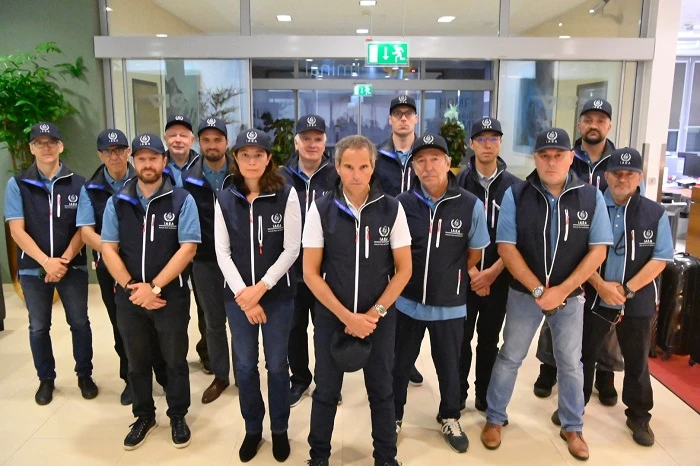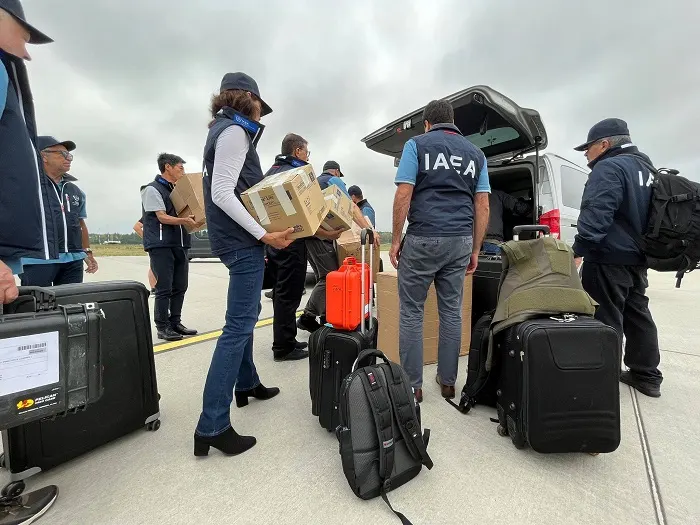A team of International Atomic Energy Agency (IAEA) nuclear inspectors arrived in the southern Ukrainian city of Zaporizhzhia on Wednesday to help ensure nuclear safety and security at the Europe’s largest nuclear power plant and undertake vital safeguards activities.
The team of experts and inspectors, including IAEA Director General Rafael Mariano Grossi, had set off from the agency’s headquarters in Vienna for the IAEA Support and Assistance Mission to Zaporizhzhya (ISAMZ) on Monday.

The Zaporizhzya Nuclear Power Plant (ZNPP), currently controlled by Russian forces but remains operated by its Ukrainian staff, has come under repeated shelling and last week temporarily lost connection to its last remaining operational 750 kilovolt (kV) external power line.
According to the nuclear watchdog of the United Nations, the six-reactor ZNPP normally has four external power lines, but three of them were lost earlier during the ongoing conflict.
In the case of a loss of external power, the ZNPP – like other nuclear power plants around the world – still has diesel generators available to provide back-up power.
Once reaching the nuclear power plant, ISAMZ will conduct an independent assessment of the nuclear facility – assess the physical damage, determine the functionality of the main and backup safety and security systems, and evaluate the working conditions of the control room staff.
At the same time, the mission will undertake urgent safeguards activities to verify that nuclear material is used only for peaceful purposes.
As reported by IndiaNarrative.com last week, Grossi had held meetings with Alexey Likhachev, the Director General of Russian State Atomic Energy Corporation Rosatom in Istanbul, and French President Emmanuel Macron in Paris before heading to Vienna.
“Almost every day there is a new incident at or near the Zaporizhzhya Nuclear Power Plant. We can’t afford to lose any more time. I’m determined to personally lead an IAEA mission to the plant in the next few days to help stabilise the nuclear safety and security situation there,” said the IAEA chief.
Before proceeding to Zaporizhzhia, Grossi also met with Ukrainian President Volodymyr Zelenskyy in Kyiv on Tuesday and emphasised the importance of “immediate demilitarization” of the nuclear power plant.
Russia, which has repeatedly labeled the situation at ZNPP as “extremely alarming” and fraught with the risk of a man-made disaster “akin to Chernobyl”, once again said today that the escalation concerns European states in the first place.
“Growing tensions around Europe’s largest nuclear power plant, the Zaporozhye Nuclear Power Plant, are of extreme concern. It’s amazing that it’s only us. As if the nuclear power plant is located in a geographically remote place from the same Europe, and its population is protected. As if this is another ‘fairy tale’, and everything that happens in it will not affect anyone living today, in particular on the European continent,” Russian Foreign Ministry Spokesperson Maria Zakharova said in Moscow on Wednesday.
Russia also repeated that the Ukrainian forces are actively using NATO weapons – including large-caliber artillery, MLRS, drones – for shelling the targets, including those whose destruction can lead to unpredictable consequences.
“Representatives of Western liberal regimes do not even ask themselves the question whether Ukraine is using the supplied weapons to shell the Zaporozhye nuclear power plant. They don’t even consider that if a tragedy happens, it’s simply because that their ammunition will be used. We are talking, in particular, about power substations, storage facilities for spent and not yet used nuclear fuel, etc,” said Zakharova.
“We hope that the IAEA experts’ visit to NPPs, scheduled for today, will help stop the presumptuous Ukrainian authorities in their quest to provoke a nuclear catastrophe,” she added.
Also Read: UN body seeks urgent visit to Ukrainian nuclear plant after it suffers power outage




















